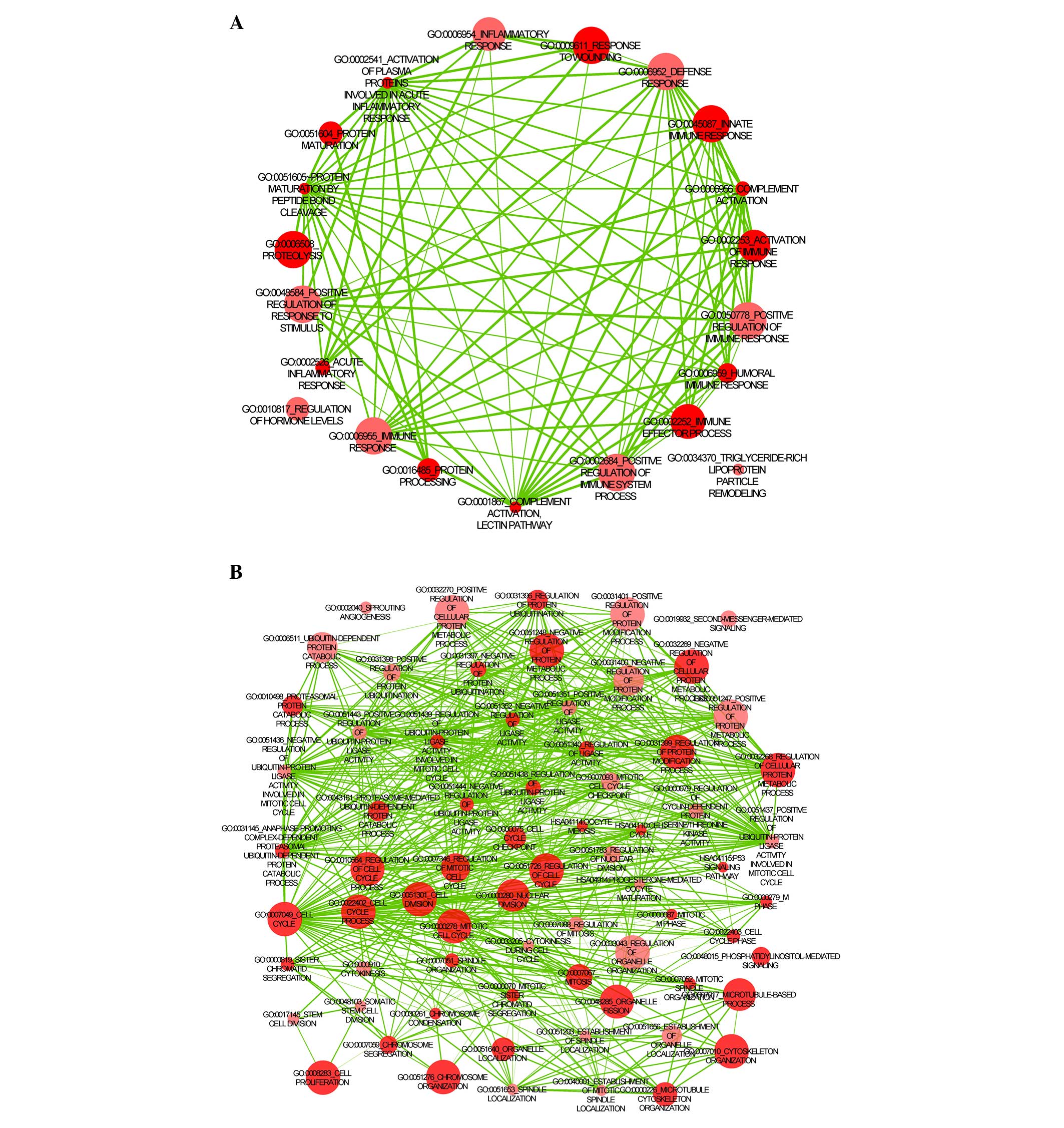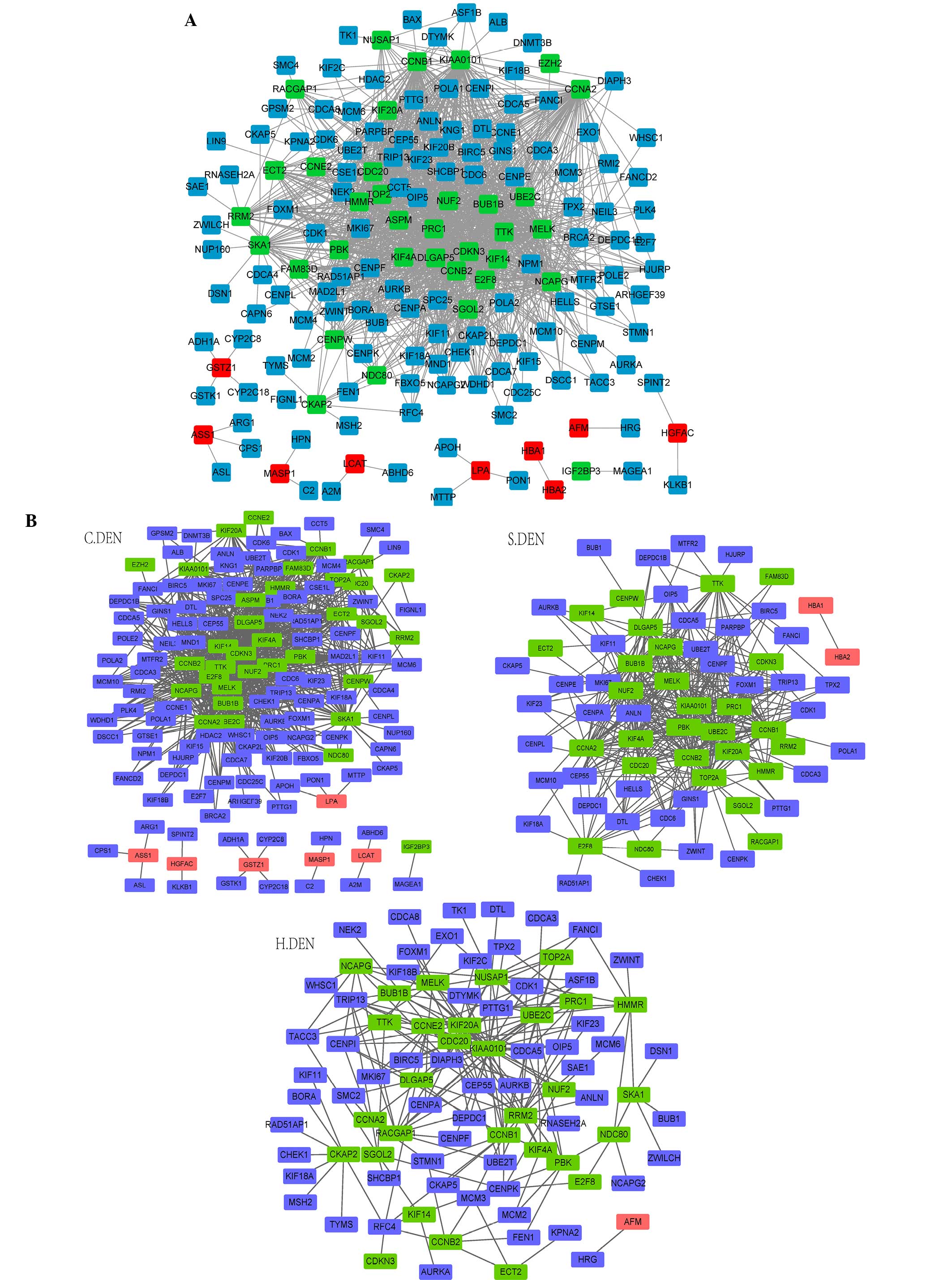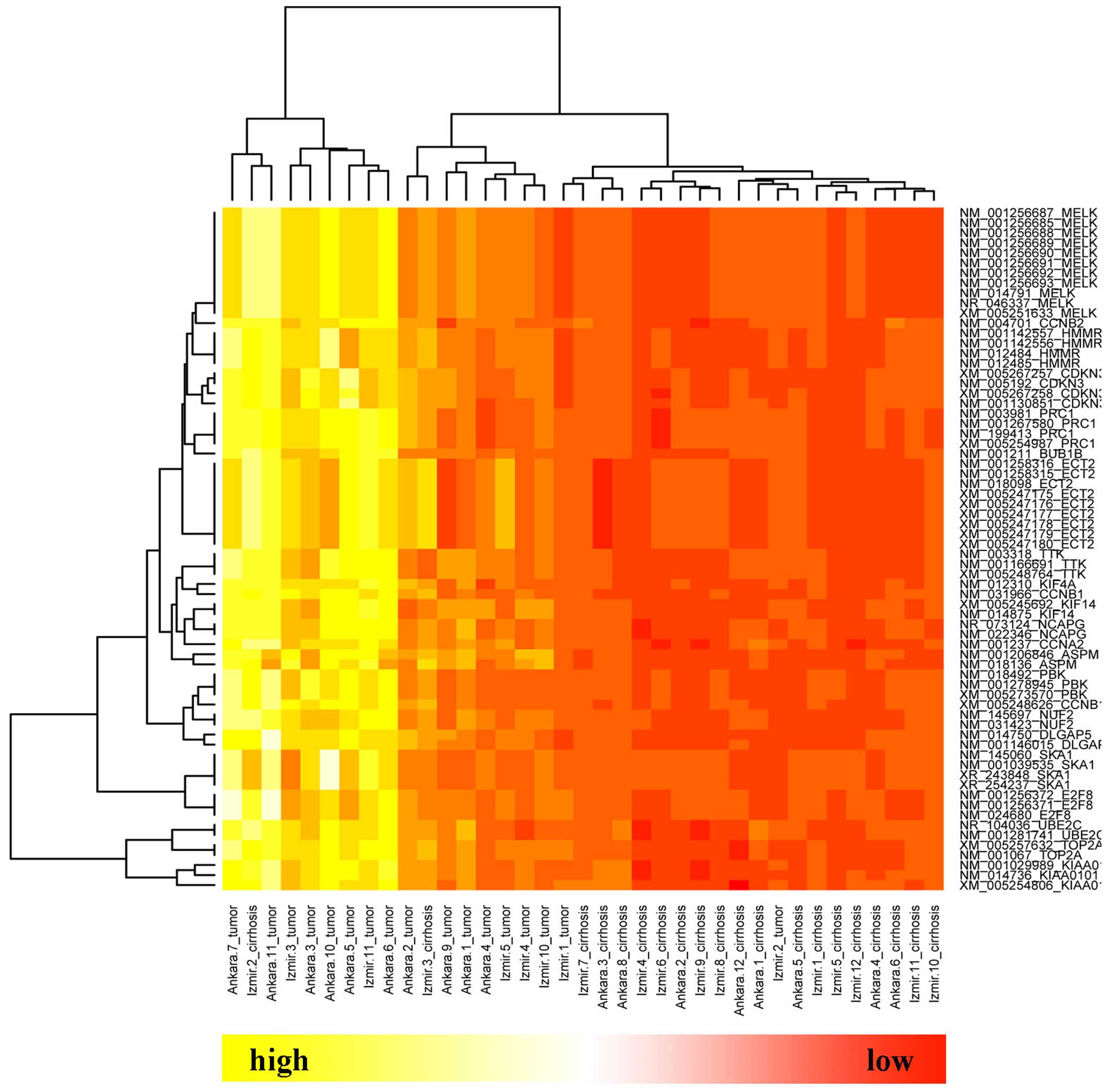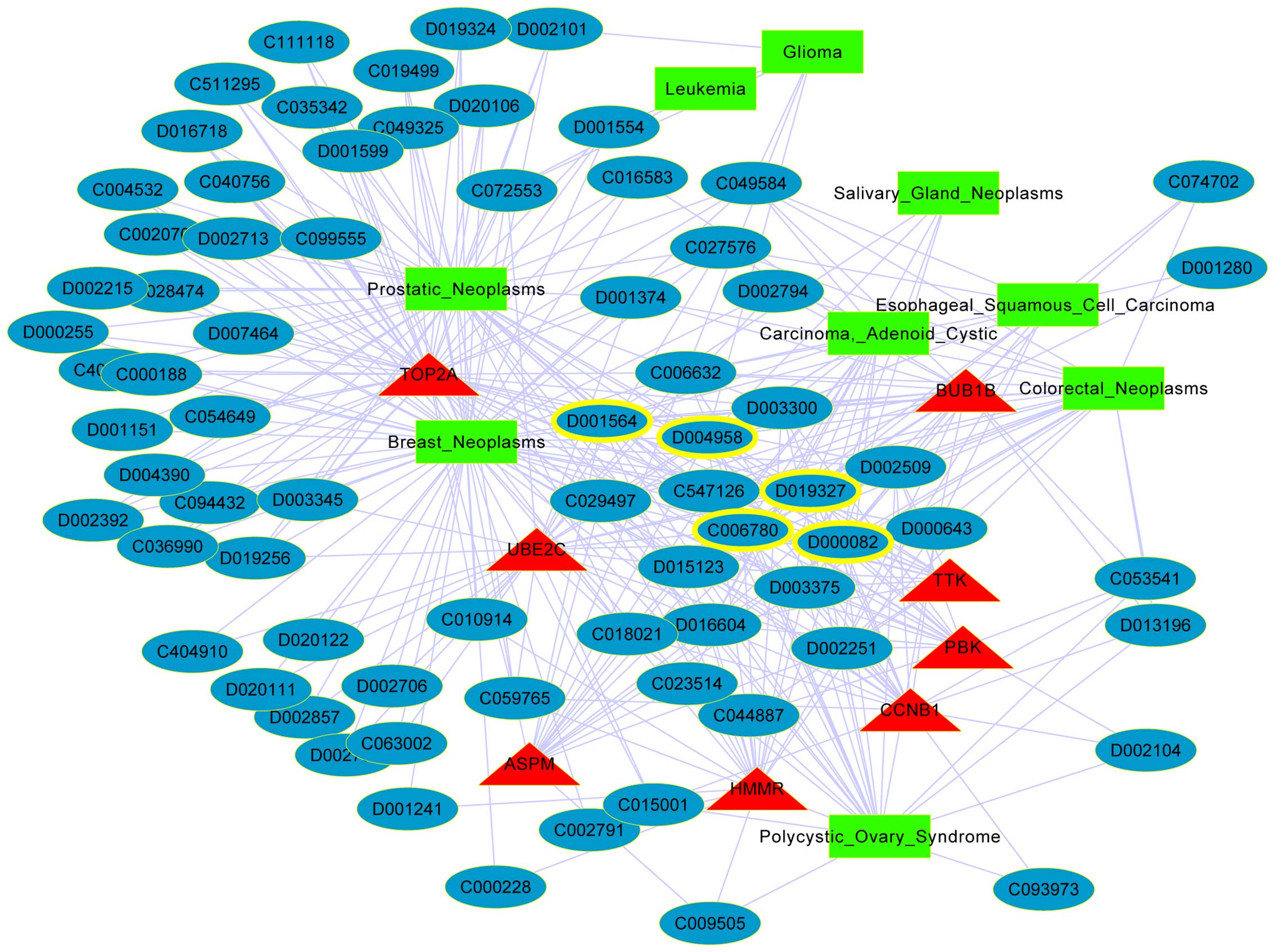|
1
|
Gandhi S, Khubchandani S and Iyer R:
Quality of life and hepatocellular carcinoma. J Gastrointest Oncol.
5:296–317. 2014.PubMed/NCBI
|
|
2
|
Mise Y, Satou S, Ishizawa T, Kaneko J,
Aoki T, Hasegawa K, Sugawara Y, Makuuchi M and Kokudo N: Impact of
surgery on quality of life in patients with hepatocellular
carcinoma. World J Surg. 38:958–967. 2014. View Article : Google Scholar : PubMed/NCBI
|
|
3
|
Jemal A, Bray F, Center MM, Ferlay J, Ward
E and Forman D: Global cancer statistics. CA Cancer J Clin.
61:69–90. 2011. View Article : Google Scholar : PubMed/NCBI
|
|
4
|
Bertino G, Demma S, Ardiri A, Proiti M,
Gruttadauria S, Toro A, Malaguarnera G, Bertino N, Malaguarnera M,
Malaguarnera M and Di Carlo I: Hepatocellular carcinoma: Novel
molecular targets in carcinogenesis for future therapies. Biomed
Res Int. 2014:2036932014. View Article : Google Scholar : PubMed/NCBI
|
|
5
|
Tanaka M, Katayama F, Kato H, Tanaka H,
Wang J, Qiao YL and Inoue M: Hepatitis B and C virus infection and
hepatocellular carcinoma in China: A review of epidemiology and
control measures. J Epidemiol. 21:401–416. 2011. View Article : Google Scholar : PubMed/NCBI
|
|
6
|
Sherman M: Hepatocellular carcinoma:
Epidemiology, risk factors, and screening. Semin Liver Dis.
25:143–154. 2005. View Article : Google Scholar : PubMed/NCBI
|
|
7
|
Schuppan D and Afdhal NH: Liver cirrhosis.
Lancet. 371:838–851. 2008. View Article : Google Scholar : PubMed/NCBI
|
|
8
|
Nordenstedt H, White DL and El-Serag HB:
The changing pattern of epidemiology in hepatocellular carcinoma.
Dig Liver Dis. 42(Suppl 3): S206–S214. 2010. View Article : Google Scholar : PubMed/NCBI
|
|
9
|
Liu CJ and Kao JH: Hepatitis B
virus-related hepatocellular carcinoma: Epidemiology and pathogenic
role of viral factors. J Chin Med Assoc. 70:141–145. 2007.
View Article : Google Scholar : PubMed/NCBI
|
|
10
|
Llovet JM, Ricci S, Mazzaferro V, Hilgard
P, Gane E, Blanc JF, de Oliveira AC, Santoro A, Raoul JL, Forner A,
et al: Sorafenib in advanced hepatocellular carcinoma. N Engl J
Med. 359:378–390. 2008. View Article : Google Scholar : PubMed/NCBI
|
|
11
|
Wörns MA, Weinmann A, Schuchmann M and
Galle PR: Systemic therapies in hepatocellular carcinoma. Dig Dis.
27:175–188. 2009. View Article : Google Scholar : PubMed/NCBI
|
|
12
|
Walther Z and Jain D: Molecular pathology
of hepatic neoplasms: Classification and clinical significance.
Patholog Res Int. 2011:4039292011.PubMed/NCBI
|
|
13
|
Stravitz RT, Heuman DM, Chand N, et al:
Surveillance for hepatocellular carcinoma in patients with
cirrhosis improves outcome. Am J Med. 121:119–126. 2008. View Article : Google Scholar : PubMed/NCBI
|
|
14
|
Pinheiro Ddo R, Ferreira WA, Barros MB, et
al: Perspectives on new biomarkers in gastric cancer: Diagnostic
and prognostic applications. World J Gastroenterol. 20:11574–11585.
2014. View Article : Google Scholar : PubMed/NCBI
|
|
15
|
Rouzier R, Pronzato P, Chéreau E, Carlson
J, Hunt B and Valentine WJ: Multigene assays and molecular markers
in breast cancer: Systematic review of health economic analyses.
Breast Cancer Res Treat. 139:621–637. 2013. View Article : Google Scholar : PubMed/NCBI
|
|
16
|
Chang AY and Wang M: Molecular mechanisms
of action and potential biomarkers of growth inhibition of
dasatinib (BMS-354825) on hepatocellular carcinoma cells. BMC
Cancer. 13:2672013. View Article : Google Scholar : PubMed/NCBI
|
|
17
|
Kim BK, Ahn SH, Seong JS, Park JY, Kim Do
Y, Kim JK, Lee Do Y, Lee KH and Han KH: Early α-fetoprotein
response as a predictor for clinical outcome after localized
concurrent chemoradiotherapy for advanced hepatocellular carcinoma.
Liver Int. 31:369–376. 2011. View Article : Google Scholar : PubMed/NCBI
|
|
18
|
Song P, Feng X, Zhang K, et al:
Perspectives on using des-γ-carboxyprothrombin (DCP) as a serum
biomarker: Facilitating early detection of hepatocellular carcinoma
in China. Hepatobiliary Surg Nutr. 2:227–231. 2013.PubMed/NCBI
|
|
19
|
Zhou Q, Mao YQ, Jiang WD, Chen YR, Huang
RY, Zhou XB, Wang YF, Shi Z, Wang ZS and Huang RP: Development of
IGF signaling antibody arrays for the identification of
hepatocellular carcinoma biomarkers. PLoS One. 7:e468512012.
View Article : Google Scholar : PubMed/NCBI
|
|
20
|
Zhang L, Li HY, Yin XL, Xu YP, Chen Y, Xie
XY, Shen YF, Ye QH and Ren ZG: Relative analysis of OPN and its
related signal molecules in hepatocellular carcinoma. Zhonghua Gan
Zang Bing Za Zhi. 19:48–51. 2011.(In Chinese). PubMed/NCBI
|
|
21
|
Zou ZQ, Ding YP, Long B, Yuh JG, Xu AL,
Lang ZW, Zou SY, Liu YD, Ding K and Li YY: Gpc-3 is a notable
diagnostic, prognostic and a latent targeted therapy marker in
hepatocellular carcinoma. Hepatogastroenterology. 57:1285–1290.
2010.PubMed/NCBI
|
|
22
|
Yildiz G, Arslan-Ergul A, Bagislar S, Konu
O, Yuzugullu H, Gursoy-Yuzugullu O, Ozturk N, Ozen C, Ozdag H,
Erdal E, et al: Genome-wide transcriptional reorganization
associated with senescence-to-immortality switch during human
hepatocellular carcinogenesis. PLoS One. 8:e640162013. View Article : Google Scholar : PubMed/NCBI
|
|
23
|
Gautier L, Cope L, Bolstad BM and Irizarry
RA: Affy-analysis of Affymetrix GeneChip data at the probe level.
Bioinformatics. 20:307–315. 2004. View Article : Google Scholar : PubMed/NCBI
|
|
24
|
Smyth GK, Michaud J and Scott HS: Use of
within-array replicate spots for assessing differential expression
in microarray experiments. Bioinformatics. 21:2067–2075. 2005.
View Article : Google Scholar : PubMed/NCBI
|
|
25
|
Dennis G Jr, Sherman BT, Hosack DA, Yang
J, Gao W, Lane HC and Lempicki RA: DAVID: Database for Annotation,
Visualization, and Integrated Discovery. Genome Biol. 4:P32003.
View Article : Google Scholar : PubMed/NCBI
|
|
26
|
Merico D, Isserlin R, Stueker O, Emili A
and Bader GD: Enrichment map: A network-based method for gene-set
enrichment visualization and interpretation. PLoS One.
5:e139842010. View Article : Google Scholar : PubMed/NCBI
|
|
27
|
Shannon P, Markiel A, Ozier O, Baliga NS,
Wang JT, Ramage D, Amin N, Schwikowski B and Ideker T: Cytoscape: A
software environment for integrated models of biomolecular
interaction networks. Genome Res. 13:2498–2504. 2003. View Article : Google Scholar : PubMed/NCBI
|
|
28
|
Franceschini A, Szklarczyk D, Frankild S,
Kuhn M, Simonovic M, Roth A, Lin J, Minguez P, Bork P, von Mering C
and Jensen LJ: STRING v9.1: Protein-protein interaction networks,
with increased coverage and integration. Nucleic Acids Res.
41(Database Issue): D808–D815. 2013. View Article : Google Scholar : PubMed/NCBI
|
|
29
|
Davis AP, Murphy CG, Johnson R, Lay JM,
Lennon-Hopkins K, Saraceni-Richards C, Sciaky D, King BL,
Rosenstein MC, Wiegers TC and Mattingly CJ: The Comparative
Toxicogenomics Database: Update 2013. Nucleic Acids Res.
41(Database Issue): D1104–D1114. 2013. View Article : Google Scholar : PubMed/NCBI
|
|
30
|
Davis AP, Murphy CG, Saraceni-Richards CA,
Rosenstein MC, Wiegers TC and Mattingly CJ: Comparative
Toxicogenomics Database: A knowledgebase and discovery tool for
chemical-gene-disease networks. Nucleic Acids Res. 37(Database
Issue): D786–D792. 2009. View Article : Google Scholar : PubMed/NCBI
|
|
31
|
Gehrmann M, Cervello M, Montalto G,
Cappello F, Gulino A, Knape C, Specht HM and Multhoff G: Heat shock
protein 70 serum levels differ significantly in patients with
chronic hepatitis, liver cirrhosis, and hepatocellular carcinoma.
Front Immunol. 5:3072014. View Article : Google Scholar : PubMed/NCBI
|
|
32
|
Sterling RK, Wright EC, Morgan TR, et al:
Frequency of elevated hepatocellular carcinoma (HCC) biomarkers in
patients with advanced hepatitis C. Am J Gastroenterol. 107:64–74.
2012. View Article : Google Scholar : PubMed/NCBI
|
|
33
|
Nahon P, Amathieu R, Triba MN, Bouchemal
N, Nault JC, Ziol M, Seror O, Dhonneur G, Trinchet JC, Beaugrand M
and Le Moyec L: Identification of serum proton NMR metabolomic
fingerprints associated with hepatocellular carcinoma in patients
with alcoholic cirrhosis. Clin Cancer Res. 18:6714–6722. 2012.
View Article : Google Scholar : PubMed/NCBI
|
|
34
|
Villegas-Ruíz V, Salcedo M,
Zentella-Dehesa A, de Oca EV, Román-Basaure E, Mantilla-Morales A,
Dávila-Borja VM and Juárez-Méndez S: A case of cervical cancer
expressed three mRNA variant of Hyaluronan-mediated motility
receptor. Int J Clin Exp Pathol. 7:2256–2264. 2014.PubMed/NCBI
|
|
35
|
Lin SY, Pan HW, Liu SH, Jeng YM, Hu FC,
Peng SY, Lai PL and Hsu HC: ASPM is a novel marker for vascular
invasion, early recurrence, and poor prognosis of hepatocellular
carcinoma. Clin Cancer Res. 14:4814–4820. 2008. View Article : Google Scholar : PubMed/NCBI
|
|
36
|
Gomez CR, Kosari F, Munz JM, Schreiber CA,
Knutson GJ, Ida CM, El Khattouti A, Karnes RJ, Cheville JC,
Vasmatzis G and Vuk-Pavlović S: Prognostic value of discs large
homolog 7 transcript levels in prostate cancer. PLoS One.
8:e828332013. View Article : Google Scholar : PubMed/NCBI
|
|
37
|
Li JQ, Kubo A, Wu F, Usuki H, Fujita J,
Bandoh S, Masaki T, Saoo K, Takeuchi H, Kobayashi S, et al: Cyclin
B1, unlike cyclin G1, increases significantly during colorectal
carcinogenesis and during later metastasis to lymph nodes. Int J
Oncol. 22:1101–1110. 2003.PubMed/NCBI
|
|
38
|
Lu J, Wen M, Huang Y, He X, Wang Y, Wu Q,
Li Z, Castellanos-Martin A, Abad M, Cruz-Hernandez JJ, et al:
C2ORF40 suppresses breast cancer cell proliferation and invasion
through modulating expression of M phase cell cycle genes.
Epigenetics. 8:571–583. 2013. View Article : Google Scholar : PubMed/NCBI
|
|
39
|
Wong N, Yeo W, Wong WL, Wong NL, Chan KY,
Mo FK, Koh J, Chan SL, Chan AT, Lai PB, et al: TOP2A overexpression
in hepatocellular carcinoma correlates with early age onset,
shorter patients survival and chemoresistance. Int J Cancer.
124:644–652. 2009. View Article : Google Scholar : PubMed/NCBI
|
|
40
|
Wang L, Sun L, Huang J and Jiang M:
Cyclin-dependent kinase inhibitor 3 (CDKN3) novel cell cycle
computational network between human non-malignancy associated
hepatitis/cirrhosis and hepatocellular carcinoma (HCC)
transformation. Cell Prolif. 44:291–299. 2011. View Article : Google Scholar : PubMed/NCBI
|
|
41
|
Nandi AK and Rapoport AP: Expression of
PDZ-binding kinase (PBK) is regulated by cell cycle-specific
transcription factors E2F and CREB/ATF. Leuk Res. 30:437–447. 2006.
View Article : Google Scholar : PubMed/NCBI
|
|
42
|
Chen X, Hou Y, Duan L, Tang M, Kang Q, Shu
J, Peng Z and Li S: Inhibitory effect of 131I-CD133mAb
combined with cisplatin on liver cancer cells in vitro and in a
tumor-bearing mouse model. Nan Fang Yi Ke Da Xue Xue Bao.
34:934–938. 2014.PubMed/NCBI
|
|
43
|
Gu W, Fang FF, Li B, Cheng BB and Ling CQ:
Characterization and resistance mechanisms of a
5-fluorouracil-resistant hepatocellular carcinoma cell line. Asian
Pac J Cancer Prev. 13:4807–4814. 2012. View Article : Google Scholar : PubMed/NCBI
|
|
44
|
Piccolella M, Crippa V, Messi E, Tetel MJ
and Poletti A: Modulators of estrogen receptor inhibit
proliferation and migration of prostate cancer cells. Pharmacol
Res. 79:13–20. 2014. View Article : Google Scholar : PubMed/NCBI
|
|
45
|
Giretti MS, Montt Guevara MM, Cecchi E,
Mannella P, Palla G, Spina S, Bernacchi G, Di Bello S, Genazzani
AR, Genazzani AD and Simoncini T: Effects of estetrol on migration
and invasion in T47-D breast cancer cells through the actin
cytoskeleton. Front Endocrinol (Lausanne). 5:802014.PubMed/NCBI
|
|
46
|
Tano K, Mizuno R, Okada T, Rakwal R,
Shibato J, Masuo Y, Ijiri K and Akimitsu N: MALAT-1 enhances cell
motility of lung adenocarcinoma cells by influencing the expression
of motility-related genes. FEBS Lett. 584:4575–4580. 2010.
View Article : Google Scholar : PubMed/NCBI
|
|
47
|
Zhao Z, Chen C, Liu Y and Wu C:
17β-Estradiol treatment inhibits breast cell proliferation,
migration and invasion by decreasing MALAT-1 RNA level. Biochem
Biophys Res Commun. 445:388–393. 2014. View Article : Google Scholar : PubMed/NCBI
|
|
48
|
Chen ZJ, Yang XL, Liu H, Wei W, Zhang KS,
Huang HB, Giesy JP, Liu HL, Du J and Wang HS: Bisphenol A modulates
colorectal cancer protein profile and promotes the metastasis via
induction of epithelial to mesenchymal transitions. Arch Toxicol.
89:1371–1381. 2015. View Article : Google Scholar : PubMed/NCBI
|
|
49
|
Chen Z, Zhang C, Wu D, Chen H, Rorick A,
Zhang X and Wang Q: Phospho-MED1-enhanced UBE2C locus looping
drives castration-resistant prostate cancer growth. EMBO J.
30:2405–2419. 2011. View Article : Google Scholar : PubMed/NCBI
|
|
50
|
Ba Q, Li J, Huang C, Qiu H, Li J, Chu R,
Zhang W, Xie D, Wu Y and Wang H: Effects of benzo[a]pyrene exposure
on human hepatocellular carcinoma cell angiogenesis, metastasis,
and NF-κB signaling. Environ Health Perspect. 123:246–254.
2015.PubMed/NCBI
|
|
51
|
Larson AM, Polson J, Fontana RJ, Davern
TJ, Lalani E, Hynan LS, Reisch JS, Schiødt FV, Ostapowicz G, Shakil
AO, et al: Acetaminophen-induced acute liver failure: Results of a
United States multicenter, prospective study. Hepatology.
42:1364–1372. 2005. View Article : Google Scholar : PubMed/NCBI
|
|
52
|
Gupte A and Mumper RJ: Elevated copper and
oxidative stress in cancer cells as a target for cancer treatment.
Cancer Treat Rev. 35:32–46. 2009. View Article : Google Scholar : PubMed/NCBI
|


















